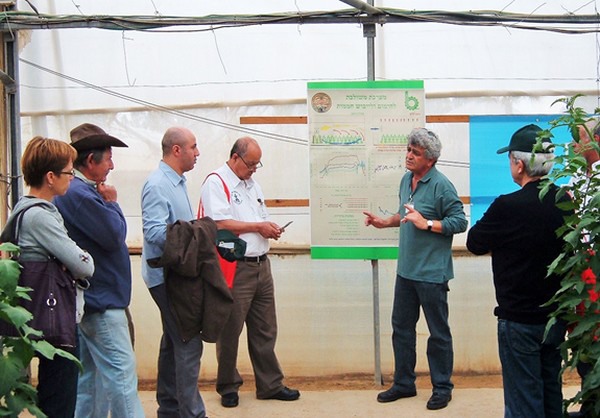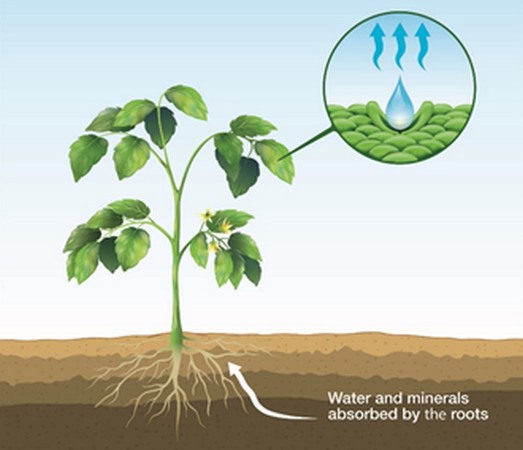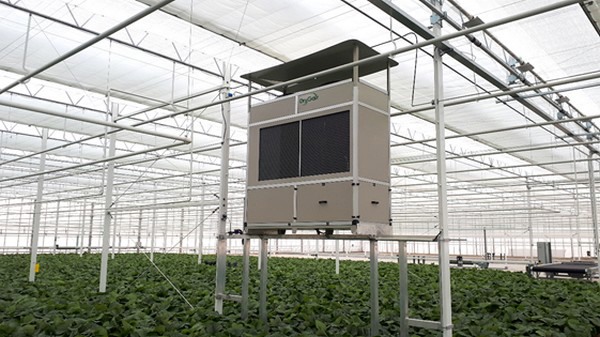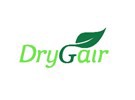Dr. Arbel is a renowned greenhouse climate researcher, who focuses on improving greenhouse growing conditions and optimizing energy consumption. He’s recently retired after 43 years at the Volcani Agricultural Research Institute in Israel, leaving behind a vast legacy. Among the many papers and patents he’s written and developed, he’s also credited with inventing the DryGair dehumidification system.

Dr. Avraham Arbel giving a presentation at Volcani Institute
Researching greenhouse humidity and developing the DryGair solution
Dr. Arbel developed DryGair while working at the Volcani Institute, where he researched how climate conditions impact greenhouse growing.
What led you to research humidity in greenhouses?
“Back then, humidity wasn’t something growers thought too much about. Everyone discussed how temperatures are critical and need to be controlled. But the understanding of how humidity affects growth, as well as energy usage, wasn’t there yet.”
The importance of greenhouse climate control
“Every crop has its ideal climate setting. So it’s important to optimize if you want to grow the highest quality produce,” says Dr. Arbel. “Part of that is preventing diseases,” he adds. “There are two main types of greenhouse diseases – those that like humid conditions, and those that develop in dry conditions.”
“Most humidity-related diseases and molds develop in very high humidity, or require free water, which is also a result of high humidity. Needless to say, if you have mildew in your greenhouse, plants won’t grow as well, and the quality of your product will suffer.”
Dr. Arbel continues, “Botrytis and other mildews develop quickly, it only takes a few hours of high humidity for them to develop. They can then spread throughout the greenhouse even if humidity goes back down.”
Is dehumidification necessary to prevent mildew outbreaks? Isn’t heating enough?
“Temperature and humidity are closely related. This is why we try to control both. We want to prevent water from condensing in the greenhouse and keep the plants as dry as possible. For that, we need to provide the ideal relative humidity levels, as well as temperature range.”
Dr. Arbel adds, “Diseases aren’t the only issue with humidity. When humidity is too high, plants have a hard time transpiring. This means they struggle to transport and break down nutrients, and they grow much slower. When relative humidity is lower than 100%, they start moving water and being active.”
 The plant’s water cycle – in through the roots and out through the leaves
The plant’s water cycle – in through the roots and out through the leaves
How humidity control affects energy consumption
One of the biggest expenses in greenhouse growing is energy. How does heating and humidity control affect the overall energy consumption of a greenhouse?
“Much of the energy growers invest is into heating. So avoiding heat loss is a big part of improving energy efficiency,” says Dr. Arbel. “Generally speaking, greenhouses lose heat in two ways. First, is through the cover, which can be reduced by improving insulation.”
“Second, is through ventilation. This is more problematic because growers ventilate to release moisture. But when you ventilate, you release hot air from the greenhouse and introduce cold air. So you need to reheat. That’s incredibly inefficient.”
Dr. Arbel adds that dehumidification isn’t just about energy efficiency. It’s also about providing the best conditions, at all times.
“On a humid night, ventilating may not even help in reducing humidity. So, it’s not just inefficient, sometimes it simply doesn’t work, leaving growers with high humidity and botrytis outbreaks. The only solution, other than dehumidifying, would be to heat even more, which also harms the plants. Not to mention it’s expensive.”
Calculating energy requirements for dehumidification vs. heating and venting
Can you tell us exactly how much energy you can save by closing the greenhouse and using dehumidifiers overnight, or when it’s humid outside?
“Let’s use an example. Say a grower needs to remove 45 liters of water per hour during the night to maintain ideal humidity levels – around 80% RH. We found that using heating and venting, they would need to invest an average of 75kW to reheat the greenhouse back to optimal temperatures – around 18°C.”
Dr. Arbel continues, “With DryGair, growers can completely close the greenhouse, using absolutely no ventilation, and not lose any heat.”

DryGair DG-12 in greenhouse
“DG-12, for example, only needs 10kW to remove 45 liters per hour, under the same conditions of 80% RH and 18°C. So, you’re already saving a substantial amount of energy. But even the electricity the DG unit uses ends up back in the greenhouse in the form of heat. So, in essence, it’s an 85kW difference."
Dr. Arbel continues, “By keeping the greenhouse closed, with thermal screens spread, you increase your insulation, which further improves energy efficiency and growing conditions. You also retain all of the CO2 inside the greenhouse and substantially reduce the need for sprays like fungicides.”
Optimizing growth and minimizing expenses
So how do you summarize the importance of greenhouse climate and humidity control?
“Greenhouse climate control is all about optimizing growth while minimizing expenses. When we developed DryGair, that was the thought process. I realized that humidity is a big issue for growers. On one hand, it harms the crops, and on the other hand, there wasn’t an efficient way to deal with it.”
Dr. Arbel adds “We started out by focusing on humidity and energy. But we discovered many benefits over time, in various areas. It helps stimulate growth, prevents diseases organically, and even helps growers optimize labor protocols, by making it possible to begin work right away, when the sun rises.”
“But most importantly – it’s an economical solution that helps growers in the real world. That was always important to us.”

 DryGair Energies
DryGair Energies